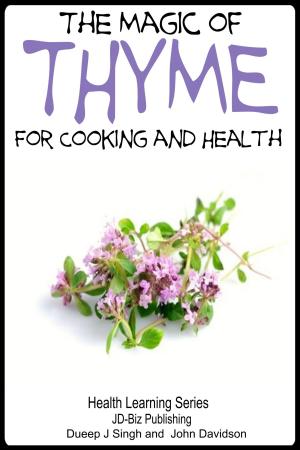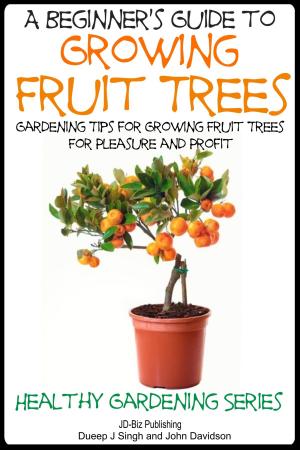Health Benefits of Thyme For Cooking and Health
Nonfiction, Home & Garden, Gardening, Herbs, Food & Drink, Herbs & Spices| Author: | M Usman, John Davidson | ISBN: | 9781311205001 |
| Publisher: | JD-Biz Corp Publishing | Publication: | July 30, 2014 |
| Imprint: | Smashwords Edition | Language: | English |
| Author: | M Usman, John Davidson |
| ISBN: | 9781311205001 |
| Publisher: | JD-Biz Corp Publishing |
| Publication: | July 30, 2014 |
| Imprint: | Smashwords Edition |
| Language: | English |
Health Benefits of Thyme For Cooking and Health
Table of Contents
Getting Started
Chapter # 1: Intro
Chapter # 2: Nutritional Worth
Chapter # 3: Selection and Storage
Chapter # 4: Growing Thyme
Chapter # 5: Species of Thyme
Health Benefits of Thyme
Chapter # 1: Intro
Chapter # 2: Acne
Chapter # 3: Lowers the Risk of Cancer
Chapter # 4: Alleviates High Blood Pressure
Chapter # 5: Food Preservative
Chapter # 6: Treats Bronchitis
Chapter # 7: Kills the Tiger Mosquito
Chapter # 8: Treats Yeast Infections
Conclusion
References
Chapter # 1: Intro
Thyme itself is not a plant or an herb; it is a collective name given to any one of the many flowering shrubs of the Thymus genus. Thyme is a member of the mint family and is a bushy, wood-based shrub with small yet highly fragranced, grayish green leaves followed by bands of pink or purple colored flowers in the early summers; it grows 15 – 30 cm tall and can be 40 cm wide. There are more than 350 different varieties of thyme all over the world, with French thyme or thymus vulgaris and lemon thyme being the most popular ones; further varieties are stated in the next chapters. Although there are a great many numbers of varieties, the general characteristics of each thyme are usually the same and it is only the color and dimensions that varies.In the medical community, the different species of thymes are distinguished by the composition of their essential oils.
Thyme is incredibly versatile and blends seamlessly with almost all kinds of foods, especially in combination with basil, lemon and garlic.Generally, thyme enlightens and brings up the flavor of any dish. This is the reason as to why many of the Italian and French recipes incorporate thyme in their ingredient list. In addition to its culinary benefits, thyme is also used in aromatherapy.
The essential oils of thyme are used in many traditional as well as clinical medicines due to their anti-viral, anti-septic, anti-parasitic, anti-rheumatic and anti-fungal properties. To delve a little deeper, thyme is a very strong detoxifying agent making it an ingredient in many of the detox food items. The herb is an excellent immunity booster, encourages white blood formation and resistance to harmful organisms. Thyme is also very effective against infections, digestive and respiratory to highlight a few. It can be taken as a cure to diarrhea and infections in the vagina (including thrush) & fallopian tubes. Its power as an anti-septic can be understood from the fact that as less as 1% thyme oil can be used to make a solution to treat gum and mouth infections. In addition, thyme is also a used as relaxant due to its soothing effect on the bronchi muscles; it helps to relieve recurring cough, asthma, dry coughs, laryngitis and bronchitis. Last but not the least, thyme being a digestive herb enhances appetite, digestion and stimulation of the liver. This is the extent of the medical properties the introduction will go to; detailed accounts on the medicinal properties of thyme will be given in subsequent sections.
Thyme is considered native to Asia and southern Europe, i.e. Mediterranean basin; it has also been cultivated in Northern America and is known to thrive there as well.
According to the Georgetown University Medical Center, the prevalence of thyme as a medically viable herb can be traced as back as 460 BC when Hippocrates, also known as the father of Western Medicine recognized it and documented its benefits in his work, Hippocratic Corpus. This is why most of the civilizations on the banks of the Mediterranean were prosperous and long-lasting. Some of these include:
The Ancient Egyptians had found use of it and were mummifying the corpses of their pharaohs with it.
The Ancient Greeks used it to burn incense in their temples and in their baths; they believed of it as a source of courage.
Romans used it to purify their rooms and to give aromatic flavoring to alcoholic beverage and cheese.
During the middle
Health Benefits of Thyme For Cooking and Health
Table of Contents
Getting Started
Chapter # 1: Intro
Chapter # 2: Nutritional Worth
Chapter # 3: Selection and Storage
Chapter # 4: Growing Thyme
Chapter # 5: Species of Thyme
Health Benefits of Thyme
Chapter # 1: Intro
Chapter # 2: Acne
Chapter # 3: Lowers the Risk of Cancer
Chapter # 4: Alleviates High Blood Pressure
Chapter # 5: Food Preservative
Chapter # 6: Treats Bronchitis
Chapter # 7: Kills the Tiger Mosquito
Chapter # 8: Treats Yeast Infections
Conclusion
References
Chapter # 1: Intro
Thyme itself is not a plant or an herb; it is a collective name given to any one of the many flowering shrubs of the Thymus genus. Thyme is a member of the mint family and is a bushy, wood-based shrub with small yet highly fragranced, grayish green leaves followed by bands of pink or purple colored flowers in the early summers; it grows 15 – 30 cm tall and can be 40 cm wide. There are more than 350 different varieties of thyme all over the world, with French thyme or thymus vulgaris and lemon thyme being the most popular ones; further varieties are stated in the next chapters. Although there are a great many numbers of varieties, the general characteristics of each thyme are usually the same and it is only the color and dimensions that varies.In the medical community, the different species of thymes are distinguished by the composition of their essential oils.
Thyme is incredibly versatile and blends seamlessly with almost all kinds of foods, especially in combination with basil, lemon and garlic.Generally, thyme enlightens and brings up the flavor of any dish. This is the reason as to why many of the Italian and French recipes incorporate thyme in their ingredient list. In addition to its culinary benefits, thyme is also used in aromatherapy.
The essential oils of thyme are used in many traditional as well as clinical medicines due to their anti-viral, anti-septic, anti-parasitic, anti-rheumatic and anti-fungal properties. To delve a little deeper, thyme is a very strong detoxifying agent making it an ingredient in many of the detox food items. The herb is an excellent immunity booster, encourages white blood formation and resistance to harmful organisms. Thyme is also very effective against infections, digestive and respiratory to highlight a few. It can be taken as a cure to diarrhea and infections in the vagina (including thrush) & fallopian tubes. Its power as an anti-septic can be understood from the fact that as less as 1% thyme oil can be used to make a solution to treat gum and mouth infections. In addition, thyme is also a used as relaxant due to its soothing effect on the bronchi muscles; it helps to relieve recurring cough, asthma, dry coughs, laryngitis and bronchitis. Last but not the least, thyme being a digestive herb enhances appetite, digestion and stimulation of the liver. This is the extent of the medical properties the introduction will go to; detailed accounts on the medicinal properties of thyme will be given in subsequent sections.
Thyme is considered native to Asia and southern Europe, i.e. Mediterranean basin; it has also been cultivated in Northern America and is known to thrive there as well.
According to the Georgetown University Medical Center, the prevalence of thyme as a medically viable herb can be traced as back as 460 BC when Hippocrates, also known as the father of Western Medicine recognized it and documented its benefits in his work, Hippocratic Corpus. This is why most of the civilizations on the banks of the Mediterranean were prosperous and long-lasting. Some of these include:
The Ancient Egyptians had found use of it and were mummifying the corpses of their pharaohs with it.
The Ancient Greeks used it to burn incense in their temples and in their baths; they believed of it as a source of courage.
Romans used it to purify their rooms and to give aromatic flavoring to alcoholic beverage and cheese.
During the middle















